A new high in strangeness.
If the 20mm Russar and 400mm Telyt were odd ducks in my lens tool kit over the years, this one takes the biscuit.
It’s the Leica close-up kit marketed in the 1950s which I owned for many years. I say “owned” rather than “used” because it was much more fun to assemble this collection of hardware and play with it than it was to use.
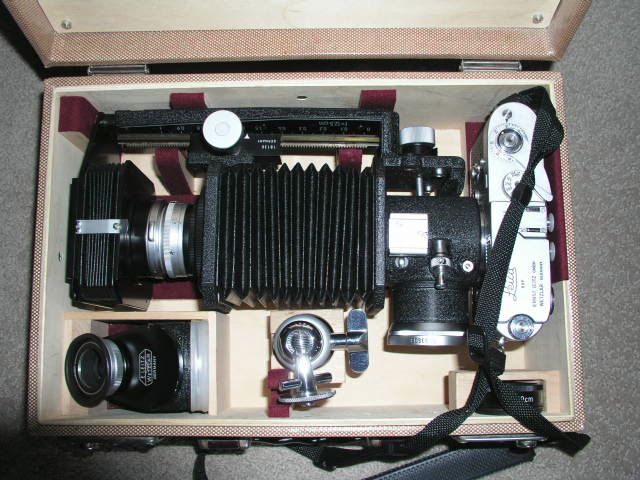
The Leitz close-up kit.
What you see in the neat fitted box is my Leica M2 attached to a Visoflex I mirror housing. The housing is attached to the Leitz Focusing Bellows I fitted with a 135mm f/4.5 Hektor lens head and a compendium lens shade – the latter extendable at will for very effective shielding of the lens. There’s a fine 45 degree right-way-round prism finder lower left. An excellent Leitz ball and socket head is lower center. These are beautifully made and I continue to use a variant on my monopod with the Panasonic G1. Highly recommended if you can track one down on the used market – exceptionally engineered, very secure when tightened owing to the design of the ball and indestructible. Attach a QR plate and you are done.
It’s hard to put into words how beautifully engineered everything in this kit really was. Every component speaks to the very height of the machinist’s art and confirms that Leitz’s quality and finish had only one way to go once the fifties ended. Downhill.
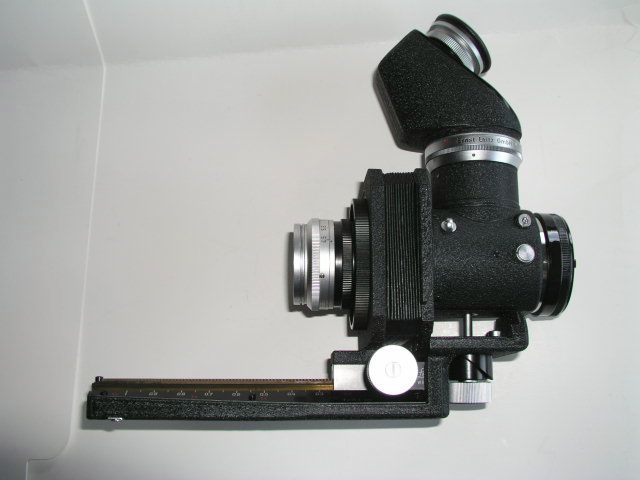
The lens fitted to the assembled Visoflex I and Bellows I
The idea of a continuous focusing range from infinity to life size was not new at that time – large technical cameras with long extension bellows had been doing that trick for ages – but seldom had it been executed as elegantly as here, especially in the 35mm film format.
The fitted case also accommodated a dual cable release with adjustable pin lengths. The idea was that the longer pin would raise the flapping mirror in the Visoflex I and further pressure on the plunger would then trip the camera’s shutter. It worked well.
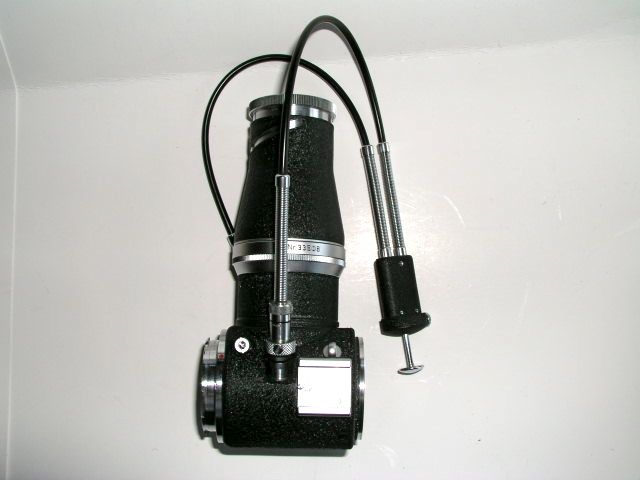
Double cable release attached to the Visoflex I.
Everything was designed just so, right down to the bracing blocks in the lid of the case which made absolutely sure that your precious gear would not flail about in transit.
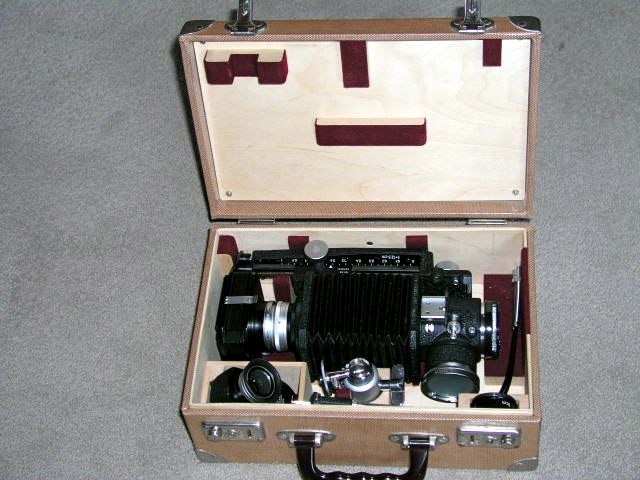
Truly a fitted case.
A second finder in the kit provided a reverse waist level view and, as you can see, the mirror in the Visoflex I was well oversized, for better function with long lenses.
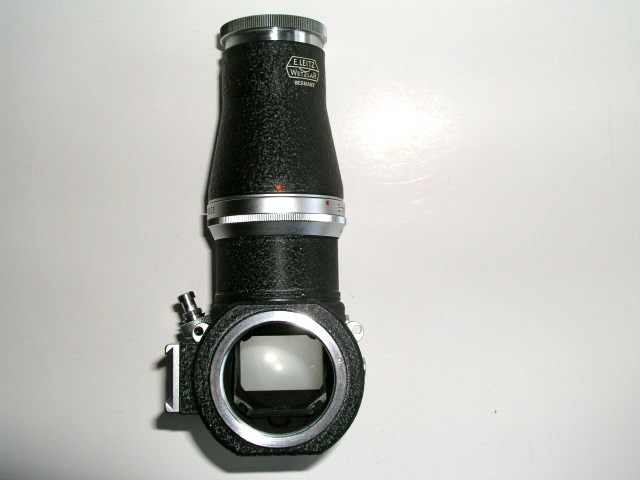
With the waist level viewfinder in place.
In practice the 45 degree finder was far superior, offering an unreversed image at chest height, and included eyesight adjustment. Perfect.
Focusing, however, was far from perfect. The plain ground glass screen in the Visoflex I had no focusing aids and lacked a fresnel lens, so light drop off to the edges was severe. You simply opened the lens up to its modest f/4.5 maximum aperture (nope,no click stops here) and then racked it back and forth either side of what you though was sharp until it looked as good as you could get it. Then, fingers crossed, you pressed the button or rather you depressed the plunger on the twin release, trying not to forget to stop the lens down first. Of course, as the lens was completely manual things went dark really fast, so that handheld photography was pretty much out of the question. Definition at f/4.5 was iffy and depth of field so shallow that only the very lucky tried to use this apparatus hand held.
The compendium lens hood just went to prove that the engineers and designers at Leitz, Wetzlar had spared no expense. Like everything else in the kit it was beautifully made, slipped into the front of the bellows focusing rack on two chromed rods and clipped neatly to the front of the Hektor lens head in the groove provided.

The compendium lens hood for the Visoflex I.
The Hektor lens head was ordinarily sold with a coupled rangefinder focusing mount but for use with this kit the head was detached from the rangefinder mount and inserted into an adapter tube for fitting to the Bellow. Leitz wallowed in an orgy of adapters for seemingly everything in those days and various other lens heads had to use specific types. However only the rare 125mm f/2.5 Hektor and the 135mm Hektor and, later, Elmar and Tele Elmar kens heads would focus to infinity. You could also fit the 200mm and 400mm Telyt heads if you could find a second tripod to support the whole thing. The 135mm Hektor was a decent pre-war four element design and gained anti-reflection coating during the war years, being replaced by the more capable Elmar and, later the even better Tele Elmar which was the last 135mm rangefinder lens Leitz made with a detachable head. The even later 135mm Apo-Telyt-M was strictly for use on a Leica M body, with a fixed head. It was quite superb for its intended purpose, as my copy testified, provided your Leica M’s rangefinder was properly calibrated. Many were not and only the M3 with its nearly life-sized finder could really do the lens justice at full aperture and close focus distances when it came to dead on focusing.
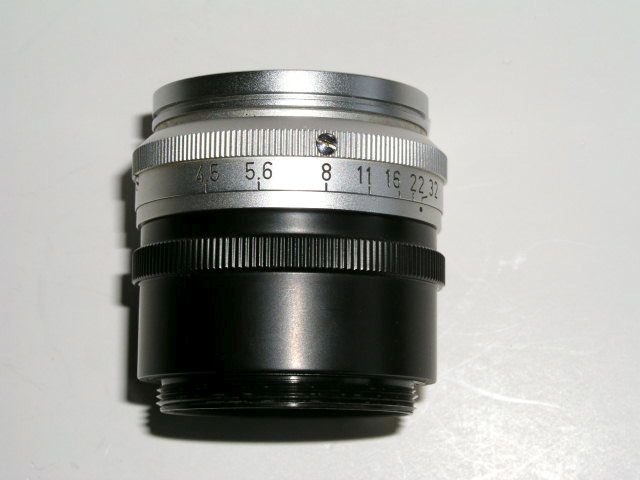
The Hektor lens head fitted to its intermediate collar.
It’s some reflection on how times have changed when this sixty year old gear is compared to a modern full frame DSLR. My Canon 5D fitted with the Canon 100mm f/2.8 EF Macro and a ring flash offers focusing from infinity to life-size in a standard focus mount – no bellows needed! – is auto focus and auto aperture, delivers quality which will knock your socks off, and is easy to use handheld. There’s even a costlier ‘L’ version available with anti-shake technology. As these things go it’s also relatively compact, if not lightweight. None of that could be said of the Leitz outfit but the craven functionality of the Canon gear lacks everything the Leitz hardware possesses in spades. Sheer physical engineering beauty.
I have taken more great pictures with the Canon gear than I can recall but cannot recall having taken one half decent picture with the Leitz outfit – which is why you see none her.
But it sure was nice to look at. I bought and sold mine, after many years of ownership, for a song.